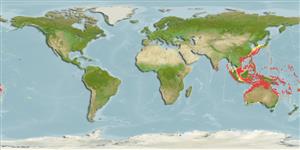Crinoidea |
Comatulida |
Comatulidae
Environment: milieu / climate zone / djupintervall / distribution range
Ekologi
; djupintervall 0 - 278 m (Ref. 81020). Tropical
Indo-West Pacific: from Maldives to Solomon Islands and from southern Japan to northern Australia.
Length at first maturity / Size / Weight / Age
Könsmognad: Lm ? range ? - ? cm
Inhabits live or dead corals in shallow water (Ref. 800). Under overhangs (Ref. 10128). Also on reef slope; on rubble and sandy bottom. Usually semicryptic in reef crevices (Ref. 100368). Known as a host to various crustaceans (Refs. 100838, 102275). Seen among alpheids, pontoniines, galatheids, and myzostomes (Ref. 101028). Suspension feeder (Ref. 68823).
Life cycle and mating behavior
Könsmognad | Reproduktion | Lek | Eggs | Fecundity | Larvae
Members of the class Crinoidea are gonochoric. During spawning, the pinnule walls rupture and the eggs and sperms are shed into the seawater. Life cycle: Embryos elongate into free-swimming larvae (doliolaria) which later sink to the bottom where they metamorphose into stalked sessile crinoid.
Lane, D.J.W., L.M. Marsh, VandenSpiegel and F.W.E. Rowe 2000 Echinoderm fauna of the South China Sea: an inventory and analysis of distribution patterns. The Raffles Bulletin of Zoology (Suppl. 8):459-493. (Ref. 81020)
IUCN Red List Status
(Ref. 130435: Version 2025-1)
CITES status (Ref. 108899)
Not Evaluated
Not Evaluated
Threat to humans
Human uses
| FishSource |
Verktyg
Ytterligare information
Trophic EcologyFood items (preys)
Födosammansättning
Födointag
Predatorer
Population dynamicsTillväxt
Max. ages / sizes
Length-weight rel.
Length-length rel.
Length-frequencies
Mass conversion
Abundans
PhysiologySyreförbrukning
Human RelatedStamps, coins, misc.
Internet-källor
Estimates based on models
Preferred temperature
(Ref.
115969): 15.4 - 27.8, mean 23.9 (based on 404 cells).
